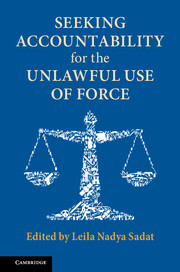Book contents
- Frontmatter
- Dedication
- Contents
- Notes on Contributors
- Foreword
- Preface
- Table of Cases
- Introduction
- PART I HISTORIC AND CONTEMPORARY PERSPECTIVES ON THE UNLAWFUL USE OF FORCE
- PART II MECHANISMS FOR RESTRAINING THE UNLAWFUL USE OF FORCE AND ENHANCING ACCOUNTABILITY
- 7 Commissions of Inquiry and the Jus ad Bellum
- 8 The International Court of Justice and the Use of Force
- 9 The Other Enemy: Transnational Terrorists, Armed Attacks, and Armed Conflicts
- 10 Toward the Substantive Convergence of International Human Rights Law and the Laws of Armed Conflict: The Case of Hassan v. the United Kingdom
- 11 International Law on the Use of Force: Current Challenges
- PART III THE ILLEGAL USE OF FORCE AND THE PROSECUTION OF INTERNATIONAL CRIMES
- PART IV IMAGINING A BETTER WORLD
- Epilogue
- Index
9 - The Other Enemy: Transnational Terrorists, Armed Attacks, and Armed Conflicts
from PART II - MECHANISMS FOR RESTRAINING THE UNLAWFUL USE OF FORCE AND ENHANCING ACCOUNTABILITY
Published online by Cambridge University Press: 21 May 2018
- Frontmatter
- Dedication
- Contents
- Notes on Contributors
- Foreword
- Preface
- Table of Cases
- Introduction
- PART I HISTORIC AND CONTEMPORARY PERSPECTIVES ON THE UNLAWFUL USE OF FORCE
- PART II MECHANISMS FOR RESTRAINING THE UNLAWFUL USE OF FORCE AND ENHANCING ACCOUNTABILITY
- 7 Commissions of Inquiry and the Jus ad Bellum
- 8 The International Court of Justice and the Use of Force
- 9 The Other Enemy: Transnational Terrorists, Armed Attacks, and Armed Conflicts
- 10 Toward the Substantive Convergence of International Human Rights Law and the Laws of Armed Conflict: The Case of Hassan v. the United Kingdom
- 11 International Law on the Use of Force: Current Challenges
- PART III THE ILLEGAL USE OF FORCE AND THE PROSECUTION OF INTERNATIONAL CRIMES
- PART IV IMAGINING A BETTER WORLD
- Epilogue
- Index
Summary
INTRODUCTION
The Islamic State of Iraq and Syria (ISIS) has emerged as an enemy like no other in the post-Charter era. Its modus operandi, combined with its extraordinary capability, has galvanized a broad Coalition of States to stand up in opposition against it, although a much smaller number have been prepared to engage in active combat. The Coalition's actions in Iraq and more particularly, Syria, have raised a range of questions under the jus ad bellum and the jus in bello. This Chapter argues that while the Coalition's actions against ISIS in Syria illustrate that the jus ad bellum has adapted to meet the challenges posed by sophisticated transnational organized armed groups, lawyers are struggling to find answers to parallel challenges in the jus in bello. I examine why this is so, and why it is important for States to shrug off the shroud of secrecy in which they cloak their military operations in order to engage with the law and ensure that it remains relevant to modern challenges. A failure to do so risks international counterterrorism operations being conducted in a legal vacuum, which is contrary to the interests of organized armed groups, States, and innocent civilians caught in the cross fire.
ISIS: THE OTHER ENEMY
ISIS is an unprecedented enemy.Estimates of its total military force differ. Before Coalition airstrikes began, its force strength was estimated at 19,000–31,000.
In the first two and a half years of Coalition operations against ISIS, that number was relatively steady, demonstrating the organization's remarkable regenerating ability, reportedly based in large part on forced conscription and foreign terrorist fighters, lured to fight through ISIS's sophisticated media and public relations operations. With the tide of operations in Syria and Iraq turning against them, the last estimate of the size of ISIS's military force in Iraq and Syria was 12,000–15,000 in March 2017.
Despite the motley nature of its ranks, ISIS has demonstrated sophisticated military capabilities since it assumed control of Mosul in June 2014 – largely a result of the strict command and control exercised by the group's Military Council and the professional-grade covert and intelligence operations directed by its Security Council.
- Type
- Chapter
- Information
- Seeking Accountability for the Unlawful Use of Force , pp. 219 - 251Publisher: Cambridge University PressPrint publication year: 2018



